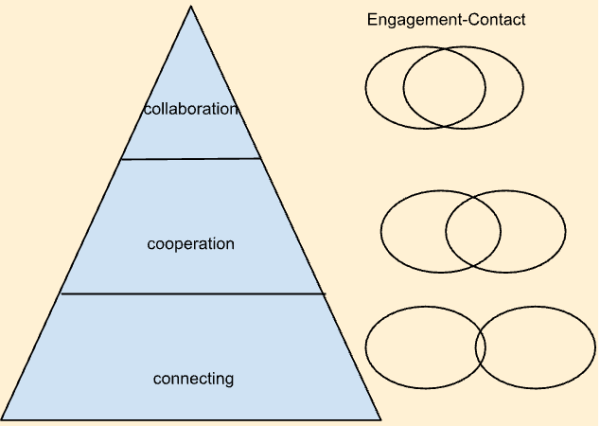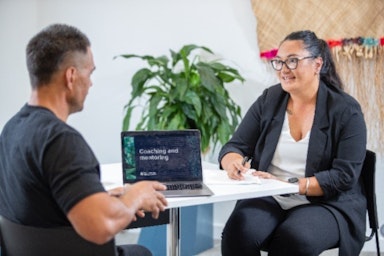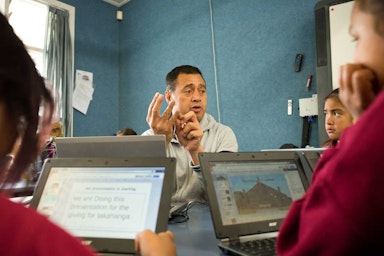Collaboration in education - so much more than parallel play
Collaboration - so much more than parallel play
Blog post by Greg Carroll, Tātai Aho Rau Regional PLD Manager and Accredited Facilitator (English-medium)
Collaboration has become a real buzzword in education in recent years. A lot has been written about its importance and I have taken the opportunity to revisit a post I wrote some years ago now unpacking different ways we engage with each other and attempting to define collaboration more closely in the Aotearoa context.
I would claim current pedagogical expectations are built upon an expectation and foundation of collaborative practice. Collaboration with ākonga and their whānau across all aspects of their educational journey is acknowledged as a key strategy to addressing equity issues and ensuring full and active participation and success in the ‘system’. Thinkers like Fullan and Timperley et al, and Sims et al all claim that collaboration is central to their understandings around effective and impactful school development and teacher professional learning.
But what does Collaboration look like? Really ....? How do we know it when we see it... hear it.... experience it? My concern as a facilitator of PLD in quite a number of schools and Kāhui Āko is that we often identify what I would call connecting or cooperating as collaboration. I believe these things are in fact quite different, and build on each other. I have attempted to capture the differences in the diagramme below:

Connecting: What does connection look like for teachers?
Connecting plays an important role in creating a collaborative learning environment. This is where teachers come together for a specific purpose and agree to work together, share resources and so on, to serve an agreed outcome or purpose. This is generally short-term and often intermittent. A lot of teachers are connecting on social media for example and this enables them to use a ‘collective intelligence’ to find specific resources or ideas. The NZ Teachers (Primary) Facebook page and Twitter in some instances could be examples of this kind of connection.
Each person who is connecting with the other educators could still function quite adequately if the relationship doesn’t exist. But it is better for professional development if individuals choose to make those connections, and positively improve their knowledge and understanding within the education sector..
This is where I suggest a metaphor of parallel play comes in. Developmentally children play alongside each other before they play together (connecting before cooperating). They use the toys to play their own games in the sand pit before they share them and play together. The venn diagram above illustrates this relationship.
Co-operating: Choosing to work together to build improved learning.
This is where the dependance is more in-depth, long term, and more closely linked. I have worked in many schools where teachers in syndicates co-operated a lot. This also happened across the staff for Units, sports days and so on. We shared students for literacy and numeracy between classes in order to cater for ranges of needs at both ends of programmes. We could have survived without the other people but our programmes and the outcomes for the students were certainly better because of the ways we worked together. We planned together for core curriculum areas, aligned Inquiry topics and shared resources and ideas for how we could make things as successful as possible for our students.
Many teachers also cooperate for their professional learning. Social media and forums like the VLN are hotbeds of people sharing ideas, practices and resources. People come together for their professional learning in PLGs or other forums at agreed time frames but often have little contact with each other in between times. They could operate without each other, but the collective brainpower of the minds working together certainly make it better.
Collaboration: An ecosystem where learners and educators support and improve each other.
This is where people are so inextricably linked that they couldn’t function without the others. The effect is much bigger than the sum of the two parts. In MLP this is the thing that makes the difference. Teachers share and organise the programme in ways that mean you couldn’t split the ways of working back into its parts again. Again the venn diagram above shows this.
Learners of all kinds collaborate in many different ways and in many different forums. There are lots of good examples of teachers and classes collaborating for their learning (eg VLN Primary). Enabling eLearning is full of in-depth and ongoing examples too. Social media can also provide forums for people to engage with each other in these ways.
The key thing here is the complete reliance on each other to achieve the shared goals. No one person could do it on their own.
Confusion: Why is there confusion between connecting, cooperating and collaborating in education?
In my experience we often see confusion between these three ‘levels’. People often refer to cooperation as collaboration in particular. True collaboration is actually still quite rare I believe. I have also seen quite a few so-called Modern or Flexible Learning Environments where in fact the teachers are simply cooperating to use the space/s provided. They share the physical spaces and places, and sometimes some of the students, but also are largely ‘the rulers of their own kingdom’ in a series of classrooms without walls in a big open space. This is often what we saw in the days of ‘Open Plan’ in the 70s and 80s.
So I guess the questions that occur to me are around how we know what a true collaborative working environment looks when we see it? How do we know what to notice? The defining questions I think we need to ask are:
- could this scenario continue to operate if one of the partners became disengaged or was not there for any length of time?
- if you analysed the ways of working, which venn diagrams above would be the most necessary to record what is happening?
If collaboration is identified as being such a critical factor for effective teaching practice (and I absolutely believe that it is!), it is essential that we know it when we see it. It is equally as critical that we know when we are not.


